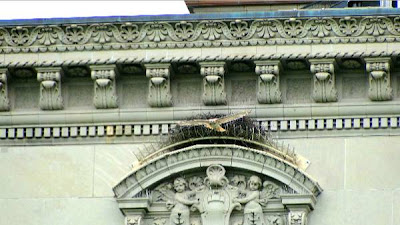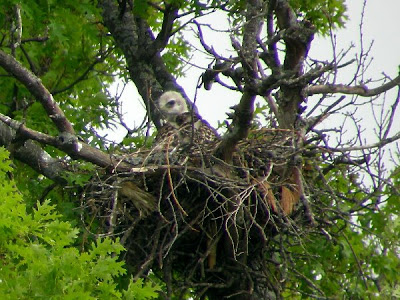 Photo by Pat Gonzalez
Photo by Pat Gonzalez
These four photos were taken last week during my most recent trip to Central Park. I was standing by the Conservatory water trying out my new tripod and zoom lens. I had it fixed on Pale Male and Lola's nest on Fifth Avenue. I noticed Pale Male moving around, so I set my camera to use its 10 frames per second feature, pressed the button to focus and held it, waiting. Then New York City's most famous hawk jumped off the building and flew towards my camera for a few seconds. I got ten clear shots. Not bad for a point-and-shoot!
Pat Gonzalez
 Photograph by Pat Gonzalez
Photograph by Pat GonzalezPat,
I cropped one of your photos to see if Pale Male was doing a little grand standing for your camera and checking you out. Sure enough, that's what he was doing. He's looking straight at you-- and into your lens.
Pale Male isn't the worlds most famous Red-tailed Hawk for nothing.
He truly does have an eye for camera equipment and photographers, and as you are new, I suspect he had to get a good look at you. Why he does it or what he is thinking when he does do it, I'd very much like to know.
He is a very charismatic fellow, full of ease and chutzpah. And why not? He is the Monarch of Central Park.
 Photograph by Pat Gonzalez
Photograph by Pat Gonzalez
 Photograph by Pat Gonzalez
Photograph by Pat Gonzalez
Photograph by Pat Gonzalez
NOW TO THE ASTORIA PARK NEST OF ATHENA AND ATLAS

5/18/09, Athena and the three eyasses at the bridge nest off Astoria Park the day Francois Portmann and I went out to take a look.
This is the "parent look" that made me think there was a third eyass and if you look carefully you can see number three on the right side of the nest. She's still too young here to remain upright like her siblings so appears as kind of a white eyass puddle with a head.
Here's a report from Astoria Hawkwatcher Robert--
Jules and I have been stopping by regularly to check on the nest and one morning met a neighbor, John, who has also been watching.
(Remember Astoria resident and hawkwatcher John from the comments section? After seeing the photographs of the nest, he said he'd be able to track it down. I told him he should look for Jules and they found each other!)
The babies are well fed and are gaining size rapidly. They are taking turns stretching their wings on the nest but are now big enough that this morning for the first time we could see clearly that there are three of them. Even when they are sleeping we can make out their heads and bodies with 8x magnification from the spot on the pedestrian bridge that looks into the nest (about 100 yards away).
Their feathers are beginning to come in and show brown.They were left alone for the longest time we've seen yet and as we bicycled around the park and neighborhood we spotted both Atlas and Athena flying in the area and hunting hard for them - they are looking a little thinner than their brood but healthy.
We are still concerned about how fledging will go but things are going really well for now.
Regards,
Robert
As we talked about in an earlier blog, this is a very tough spot to fledge from. Traffic, pavement below the nest, nothing to branch on as the pipes are too fat for them to grip, so they will very likely go early and be groundings who can't gain elevation for some time after coming off the nest.
Longtime Blog contributor Robin of Illinois sent in this article about Milton's local "Bird Lady", Dianne Moller. Dianne is a Wisconsin licensed Wildlife Rehabilitator and does wonderful work in many different areas, including education and advocacy.
http://www.charlotteobserver.com/136/story/743635.html"Dianne Moller, who runs the Hoo's Woods rehabilitation center in Milton,Wis., has received red-tailed hawks and great horned owls found at the landfill in nearby Janesville with singed feathers and feet and blistered eyes. It takes nearly a year to rehabilitate these birds because they have to molt, grow new feathers and then rebuild their strength in a flight cage before release, she said.When Moller brought a scorched hawk to landfill manager John Whitcomb last fall, he had an engineer come up with a way to weld a crown of steel spikes on the rim of the methane flare pipe to discourage hawks from perching. The landfill also installed a utility pole taller than the burner in hopes that raptors would perch there instead." "At their spring conference in Albany, the New York State Association for Solid Waste Management and the Federation of New York Solid Waste Associations passed resolutions to join Audubon's Save the Raptors campaign." AND LAST BUT NOT LEAST--THE YOUNG Ms HANG OUT IN THE NEST
Primus does a little preening then stares down at her sibling.
Then she gives me a brazen stare.
And on the left tip top of the tree perches a Kingbird. Now Kingbirds are famous for their harassment of hawks and crows but at the moment this bird is scoping the area as if the hawks didn't even exist. And for all practical purposes the hawks don't at this moment and though he is perched near a hawk's nest and one might suspect he'd be in danger of becoming dinner, that will not happen. He is absolutely safe as far as we can tell.
Why?
Because we think there is a No Kill Zone around a Red-tailed Hawk's nest. We've seen it over and over, birds within a certain perimeter of a nest are not hunted. Exactly how big this perimeter is, depends on a hawk criteria which I haven't figured out, though the Kingbird is certainly within it.
I visualize the No KIll Zone as a bubble with the nest at it's center. At the Trump Parc nest of Pale Male Jr. and Charlotte, there was a second or third floor railing on an apartment building below, by dozens of stories and slightly east of the nest. Pigeons constantly congregated on the railing without fear or harassment. At first we joked the railing and it's occupants were "The Pantry", and the hawks were saving them for a day with slim pickings, but it never happened.
It isn't totally clear but we think that the ground level below the nest isn't included in the bubble or at least most of it isn't. It is possible a small spot, that which would be the contact point of the "bubble" with the Earth would be no kill. Of course we don't have enough nests in the sample to prove the point, so far it is a hypothosis that so far as I know hasn't been categorically proved. We'd need a larger sample to make sure.
The conjecture as to why a No Kill area might be evolutionarily beneficial is that that way the parent's "wiring" precludes them from suddenly seeing a quick move by an eyass and their instinct causes them to pounce as if they were hunting, without thought, and accidentally do in their offspring.
The slitty eyed devil eyass expression.
 Secundus rises up and looks pretty feisty himself.
Secundus rises up and looks pretty feisty himself.














































